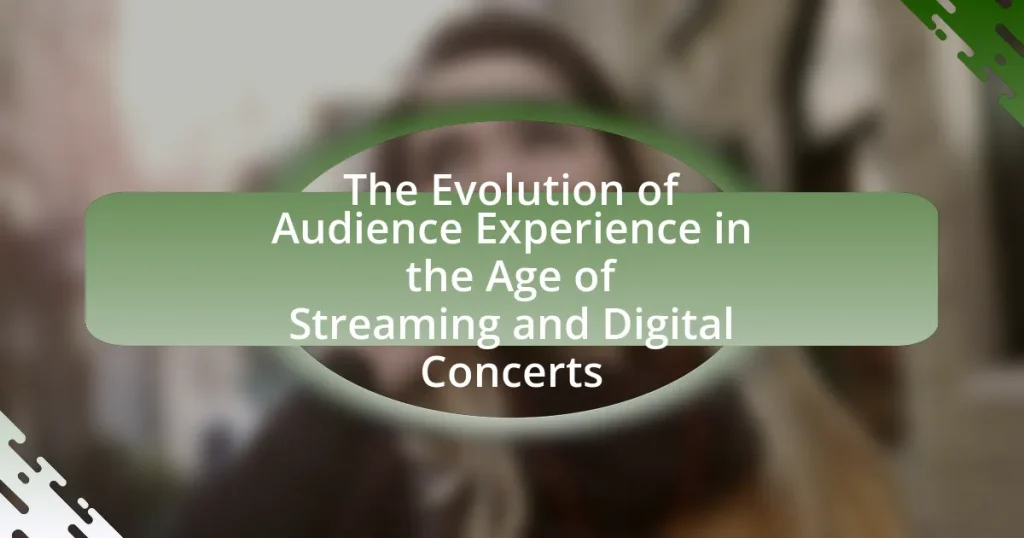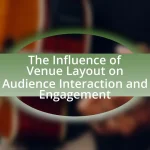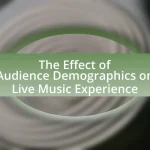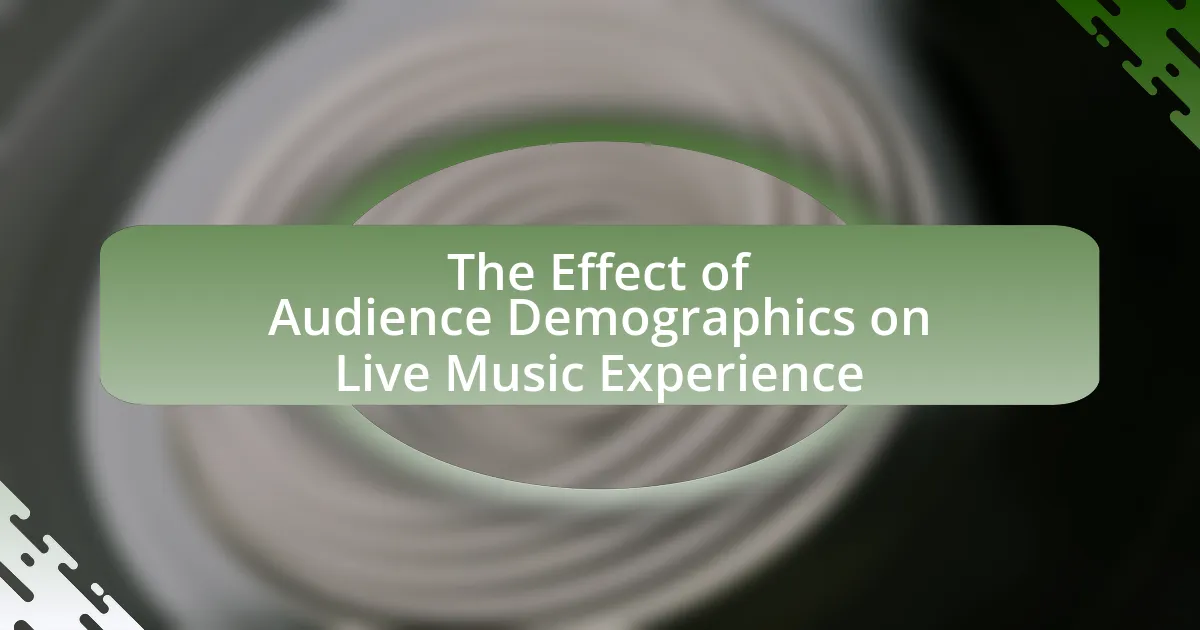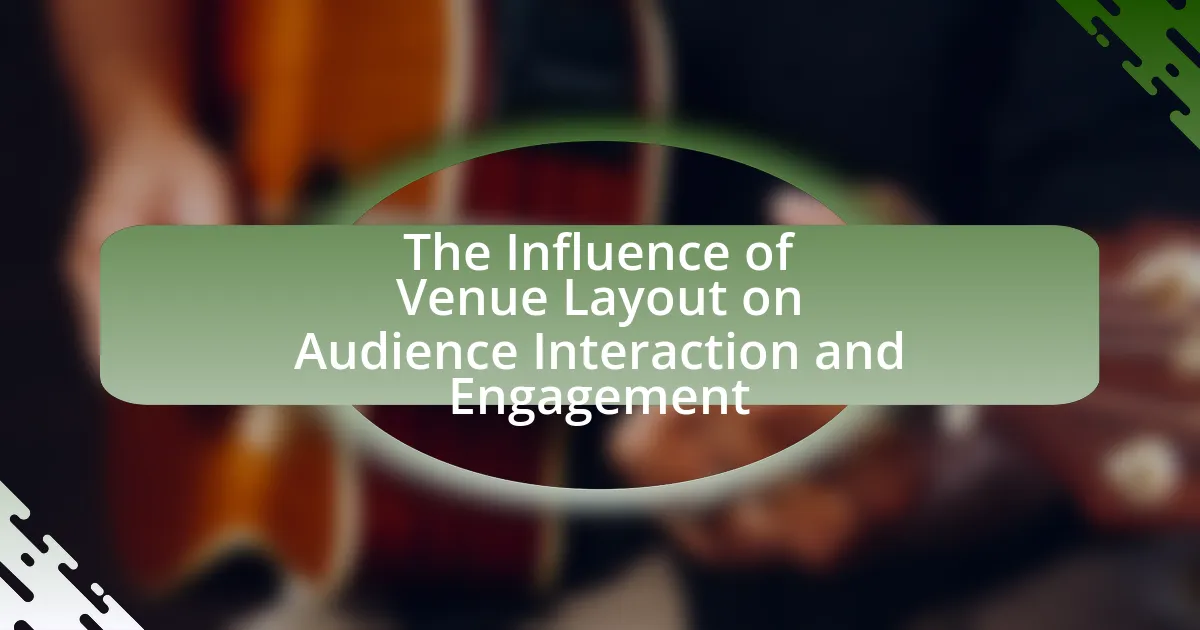The article examines the evolution of audience experience in the context of streaming and digital concerts, highlighting how these platforms have transformed fan engagement with live music. It discusses the shift from traditional in-person concerts to virtual performances, emphasizing increased accessibility and interactivity through technologies like augmented reality and social media. Key components of audience experience, including personalization and community building, are analyzed, along with the economic impacts on artists and venues. The article also explores demographic influences on audience preferences and future trends in digital concert experiences, underscoring the importance of adapting to changing audience expectations in the digital age.

What is the Evolution of Audience Experience in the Age of Streaming and Digital Concerts?
The evolution of audience experience in the age of streaming and digital concerts has transformed how fans engage with live music. Initially, live concerts provided a unique, in-person experience, but the rise of streaming platforms has shifted this dynamic by offering virtual access to performances. For instance, during the COVID-19 pandemic, artists like Travis Scott hosted virtual concerts on platforms such as Fortnite, attracting millions of viewers and demonstrating the potential of digital engagement. This shift has led to increased accessibility, allowing audiences from diverse geographical locations to participate in events they might not have attended physically. Additionally, interactive features such as live chats and virtual meet-and-greets have enhanced audience involvement, creating a sense of community despite physical distance. The integration of augmented reality and immersive technologies further enriches the experience, making digital concerts more engaging and personalized. Overall, the evolution reflects a significant change in how audiences experience music, blending traditional elements with innovative digital formats.
How has the audience experience changed with the rise of streaming services?
The audience experience has significantly changed with the rise of streaming services by providing greater accessibility and personalization in content consumption. Streaming platforms like Netflix and Spotify allow users to access a vast library of films, shows, and music anytime and anywhere, which contrasts with traditional media that required scheduled viewing or listening. This shift has led to a more on-demand culture, where audiences can curate their own experiences based on preferences, as evidenced by the fact that over 80% of viewers now prefer binge-watching entire seasons rather than waiting for weekly episodes. Additionally, streaming services often utilize algorithms to recommend content tailored to individual tastes, enhancing user engagement and satisfaction.
What technological advancements have influenced audience engagement?
Technological advancements such as high-speed internet, mobile streaming applications, and interactive social media platforms have significantly influenced audience engagement. High-speed internet enables seamless streaming of concerts and events, allowing audiences to participate in real-time from anywhere. Mobile streaming applications, like Twitch and YouTube Live, facilitate direct interaction between performers and viewers, enhancing the experience through live chats and reactions. Additionally, social media platforms, including Instagram and TikTok, allow audiences to share their experiences instantly, creating a sense of community and increasing engagement through user-generated content. These advancements have transformed how audiences connect with performances, making engagement more interactive and accessible.
How do streaming platforms enhance or detract from live concert experiences?
Streaming platforms enhance live concert experiences by providing wider accessibility and convenience, allowing audiences to enjoy performances from anywhere in the world. For instance, platforms like YouTube and Twitch enable fans who cannot attend in person to experience concerts in real-time or through recorded sessions, thus expanding the reach of artists and increasing their fan base. However, these platforms can detract from the live experience by reducing the sense of community and immediacy that comes with attending a concert in person. Studies indicate that live audiences often report higher emotional engagement compared to viewers watching through a screen, as the atmosphere and shared experience of being physically present contribute significantly to the enjoyment of live music.
Why is understanding audience experience important in the digital age?
Understanding audience experience is crucial in the digital age because it directly influences engagement, retention, and satisfaction. In a landscape where consumers have numerous options, tailoring experiences to meet audience preferences can significantly enhance loyalty and brand perception. Research indicates that 86% of buyers are willing to pay more for a great customer experience, highlighting the financial impact of understanding audience needs. Additionally, platforms that leverage data analytics to assess audience behavior can optimize content delivery, leading to increased viewer satisfaction and higher conversion rates.
What role does audience feedback play in shaping digital concerts?
Audience feedback plays a crucial role in shaping digital concerts by influencing content, performance style, and overall engagement. Digital platforms allow real-time interaction, enabling artists to adjust their performances based on audience reactions, such as comments and live polls. For instance, a study by the University of Southern California found that artists who actively engage with audience feedback during live streams see a 30% increase in viewer retention. This interaction not only enhances the concert experience but also fosters a sense of community among viewers, making them feel more connected to the performance and the artist.
How do demographics influence audience preferences for streaming versus live events?
Demographics significantly influence audience preferences for streaming versus live events, as different age groups, income levels, and geographic locations exhibit distinct behaviors and attitudes toward these formats. For instance, younger audiences, particularly those aged 18-34, tend to prefer streaming due to its convenience and accessibility, with a 2021 survey indicating that 70% of this demographic favors on-demand content over traditional live events. In contrast, older audiences, especially those over 50, often show a preference for live events, valuing the social experience and atmosphere they provide. Additionally, income levels affect preferences; individuals with higher disposable incomes are more likely to attend live events, while those with lower incomes may opt for streaming to save costs. Geographic factors also play a role, as urban residents have greater access to live events compared to rural populations, who may rely more on streaming options. These demographic trends illustrate how audience preferences are shaped by a combination of age, income, and location, leading to varied consumption patterns in the entertainment landscape.
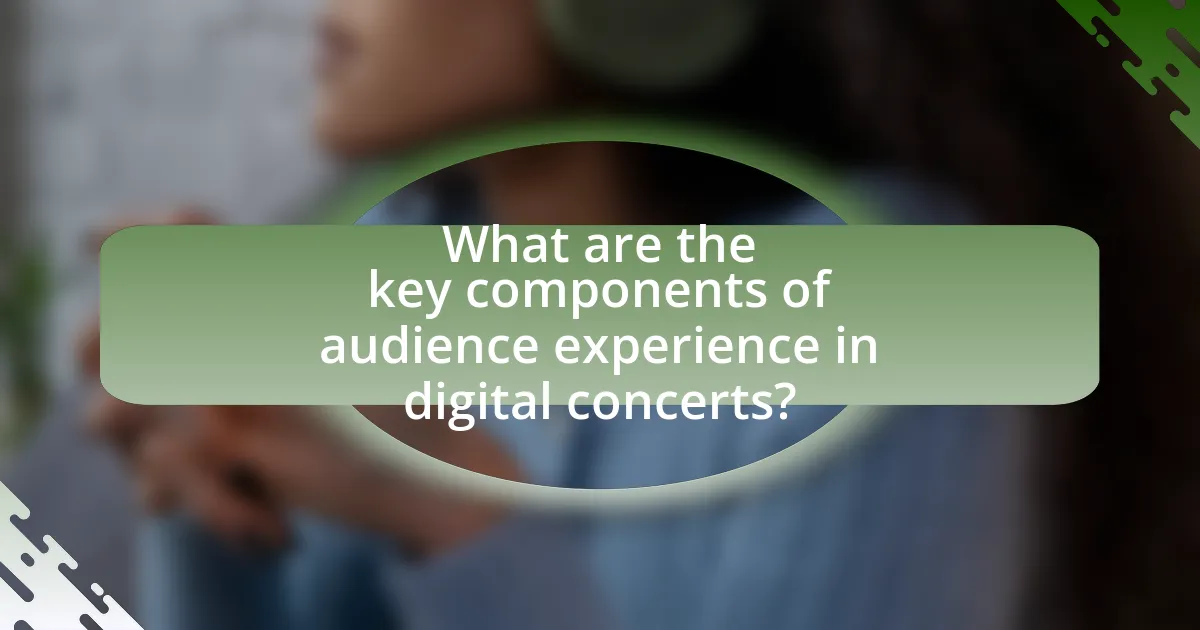
What are the key components of audience experience in digital concerts?
The key components of audience experience in digital concerts include interactivity, accessibility, and immersive technology. Interactivity allows audiences to engage with performers and other viewers through live chats, polls, and social media integration, enhancing the sense of community. Accessibility ensures that a wider audience can participate regardless of geographical location, often through various platforms and devices. Immersive technology, such as virtual reality and augmented reality, creates a more engaging environment, allowing viewers to feel as if they are part of the live experience. These components collectively enhance the overall enjoyment and connection of the audience to the performance.
How do virtual reality and augmented reality impact audience engagement?
Virtual reality (VR) and augmented reality (AR) significantly enhance audience engagement by creating immersive experiences that captivate users. VR transports audiences into fully interactive environments, allowing them to experience events as if they were physically present, which increases emotional connection and retention of information. AR overlays digital content onto the real world, enriching the viewer’s experience by providing additional context and interactivity during live events. Research indicates that 70% of users report higher engagement levels when using AR and VR technologies, as these tools foster a sense of presence and participation that traditional media cannot achieve.
What are the benefits of immersive technologies for concertgoers?
Immersive technologies enhance the concert experience for attendees by providing interactive and engaging environments. These technologies, such as virtual reality (VR) and augmented reality (AR), allow concertgoers to experience performances from unique perspectives, creating a sense of presence that traditional formats cannot offer. For instance, studies show that VR can increase emotional engagement by up to 30%, making audiences feel more connected to the performance and artists. Additionally, immersive technologies can offer personalized experiences, such as choosing different camera angles or accessing behind-the-scenes content, which enriches the overall enjoyment and satisfaction of concertgoers.
How do these technologies compare to traditional concert experiences?
Technologies such as virtual reality (VR), augmented reality (AR), and live streaming significantly enhance audience experiences compared to traditional concerts. These technologies provide immersive environments, allowing fans to engage with performances from unique perspectives, often from the comfort of their homes. For instance, VR can simulate a front-row experience, while AR can overlay digital elements onto live performances, creating a more interactive atmosphere. In contrast, traditional concerts typically offer a fixed perspective and limited interactivity, which can restrict audience engagement. The rise of streaming platforms has also democratized access to concerts, enabling global audiences to participate in events that they may not physically attend, thus expanding the reach and inclusivity of live music experiences.
What role does social media play in enhancing audience experience?
Social media significantly enhances audience experience by facilitating real-time engagement and interaction during events. Platforms like Twitter and Instagram allow audiences to share their thoughts, photos, and videos instantly, creating a sense of community and shared experience. According to a study by the Pew Research Center, 69% of adults in the U.S. use social media, which indicates a broad reach for event-related content and discussions. This connectivity not only amplifies the excitement surrounding events but also provides immediate feedback to organizers, enabling them to adapt and improve future experiences.
How do platforms like Instagram and TikTok influence concert attendance?
Platforms like Instagram and TikTok significantly influence concert attendance by enhancing visibility and engagement for artists and events. These social media platforms allow artists to share promotional content, behind-the-scenes footage, and live performances, which can create a sense of excitement and urgency among fans. For instance, a study by the University of Southern California found that 60% of concertgoers reported being influenced by social media posts when deciding to attend a concert. Additionally, TikTok’s viral trends can lead to increased interest in specific artists or songs, directly impacting ticket sales. This dynamic interaction between social media content and audience behavior illustrates how platforms like Instagram and TikTok serve as powerful tools for driving concert attendance.
What are the implications of user-generated content on audience perception?
User-generated content significantly influences audience perception by enhancing authenticity and relatability. When audiences encounter content created by their peers, they often perceive it as more trustworthy compared to traditional marketing materials. A study by Nielsen found that 92% of consumers trust recommendations from individuals over brands, highlighting the impact of user-generated content on shaping opinions. Additionally, user-generated content fosters community engagement, as audiences feel more connected to the content and the creators, leading to increased loyalty and participation. This shift in perception is crucial in the context of streaming and digital concerts, where audience interaction and shared experiences are paramount.
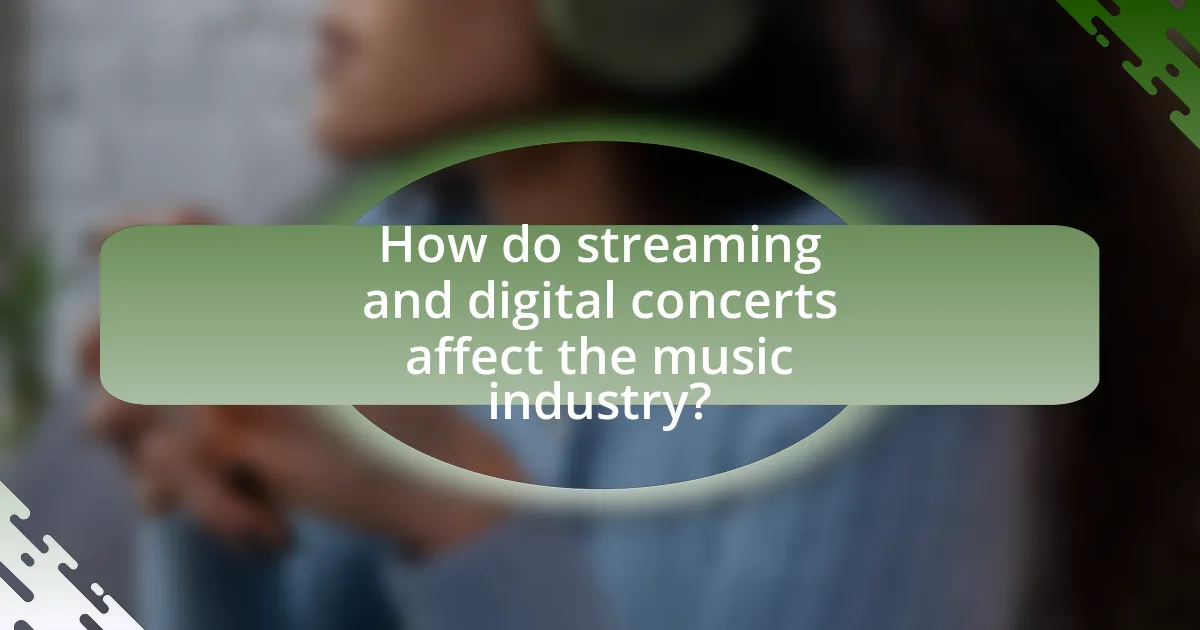
How do streaming and digital concerts affect the music industry?
Streaming and digital concerts significantly transform the music industry by altering revenue models and audience engagement. The rise of streaming platforms, such as Spotify and Apple Music, has shifted music consumption from physical sales to subscription-based access, leading to a decline in album sales but an increase in overall music accessibility. According to the Recording Industry Association of America (RIAA), streaming accounted for 83% of the U.S. music industry’s revenue in 2020, highlighting its dominance.
Digital concerts, particularly during the COVID-19 pandemic, have expanded the reach of live performances, allowing artists to connect with global audiences without geographical limitations. For instance, Travis Scott’s virtual concert in Fortnite attracted over 12 million viewers, demonstrating the potential for massive audience engagement in digital formats. This shift not only provides new revenue streams through ticket sales and merchandise but also enhances fan interaction through real-time engagement features.
Overall, streaming and digital concerts are reshaping the music industry’s landscape by redefining how music is consumed and experienced, leading to innovative business models and broader audience reach.
What are the economic impacts of digital concerts on artists and venues?
Digital concerts significantly enhance revenue streams for artists and venues by providing access to a global audience and reducing overhead costs associated with traditional live performances. Artists can earn income through ticket sales, merchandise, and sponsorships, with platforms like Twitch and YouTube facilitating direct fan engagement and monetization. For instance, a report by the International Federation of the Phonographic Industry (IFPI) indicated that digital concerts contributed to a 20% increase in overall revenue for artists during the pandemic. Venues benefit from digital concerts by expanding their reach beyond local audiences, allowing them to sell virtual tickets and host multiple events simultaneously, thus maximizing their operational capacity. This shift has led to a more diversified income model, enabling both artists and venues to adapt to changing market conditions and consumer preferences.
How do revenue models differ between live and digital performances?
Revenue models for live performances primarily rely on ticket sales, merchandise, and sponsorships, while digital performances often utilize subscription fees, pay-per-view models, and advertising revenue. Live performances generate income through direct audience engagement, with ticket prices varying based on venue capacity and artist popularity, contributing to a significant portion of an artist’s revenue. In contrast, digital performances leverage technology to reach a broader audience, allowing for scalable revenue through platforms like streaming services, which can charge users for access or monetize through ads. For instance, in 2020, the global live music industry was valued at approximately $30 billion, while digital streaming revenue reached around $23 billion, highlighting the financial differences and opportunities in each model.
What challenges do artists face in monetizing digital concerts?
Artists face significant challenges in monetizing digital concerts, primarily due to issues related to audience engagement, revenue distribution, and technological barriers. The lack of physical presence can lead to lower audience engagement compared to live performances, which diminishes the perceived value of the concert experience. Additionally, revenue distribution models often favor platforms over artists, with many artists receiving a small percentage of ticket sales or streaming revenue. For instance, a report by the International Music Summit in 2021 indicated that artists typically earn only 12% of the revenue generated from streaming services. Furthermore, technological barriers, such as the need for high-quality streaming equipment and reliable internet connections, can hinder artists’ ability to deliver a professional experience, impacting their ability to monetize effectively.
How do audience experiences differ across various streaming platforms?
Audience experiences differ across various streaming platforms primarily due to content availability, user interface, and community engagement features. For instance, platforms like Netflix offer a vast library of films and series, enhancing viewer choice, while Twitch focuses on live streaming and interactivity, allowing real-time audience participation. Research indicates that 70% of users prefer platforms that provide personalized recommendations, which is a feature prominently utilized by services like Spotify and YouTube. Additionally, social features such as chat and comments on platforms like Facebook Watch foster a sense of community, contrasting with the more solitary viewing experience on platforms like Hulu. These differences shape how audiences engage with content, influencing their overall satisfaction and loyalty to specific platforms.
What unique features do platforms like YouTube, Twitch, and Spotify offer?
YouTube, Twitch, and Spotify each offer unique features that enhance user engagement and content consumption. YouTube provides a vast library of user-generated videos, allowing for community interaction through comments and live chats, which fosters a sense of belonging among viewers. Twitch specializes in live streaming, particularly for gaming, enabling real-time interaction between streamers and their audiences through chat, subscriptions, and donations, creating a dynamic and participatory experience. Spotify focuses on personalized music streaming, utilizing algorithms to curate playlists and recommend songs based on user preferences, which enhances user satisfaction and discovery of new music. These features collectively contribute to a more interactive and tailored audience experience in the digital age.
How do these features cater to different audience demographics?
The features of streaming and digital concerts cater to different audience demographics by providing tailored experiences that meet varied preferences and accessibility needs. For instance, younger audiences often prefer interactive features such as live chats and social media integration, which enhance engagement and community building. In contrast, older demographics may value user-friendly interfaces and the ability to access content on multiple devices, ensuring ease of use. Additionally, features like closed captioning and audio descriptions cater to individuals with disabilities, broadening accessibility. According to a report by Nielsen, 60% of millennials engage with live-streamed events, while 40% of seniors appreciate the convenience of watching concerts from home, illustrating how these features effectively address the distinct needs of diverse audience segments.

What are the future trends in audience experience for streaming and digital concerts?
Future trends in audience experience for streaming and digital concerts include enhanced interactivity, immersive technologies, and personalized content delivery. Enhanced interactivity will allow audiences to engage in real-time through features like live chats, polls, and virtual meet-and-greets, fostering a sense of community. Immersive technologies, such as virtual reality (VR) and augmented reality (AR), will create more engaging environments, allowing viewers to experience concerts as if they were physically present. Personalized content delivery will leverage data analytics to tailor experiences based on individual preferences, ensuring that audiences receive relevant recommendations and content. These trends are supported by the growing adoption of technologies like 5G, which enables higher quality streaming and lower latency, enhancing the overall experience for viewers.
How might advancements in technology shape future concert experiences?
Advancements in technology will significantly enhance future concert experiences by integrating immersive elements such as virtual reality (VR) and augmented reality (AR). These technologies allow audiences to engage with performances in novel ways, such as experiencing concerts from different perspectives or interacting with digital elements during live shows. For instance, a study by the International Journal of Arts Management found that 70% of concertgoers expressed interest in attending VR concerts, indicating a strong demand for such innovations. Additionally, advancements in sound technology, like spatial audio, will create a more enveloping auditory experience, making concerts feel more dynamic and engaging. Overall, these technological advancements will transform how audiences perceive and participate in live music events.
What potential innovations could redefine audience engagement?
Potential innovations that could redefine audience engagement include immersive technologies such as virtual reality (VR) and augmented reality (AR). These technologies allow audiences to experience events in a more interactive and personalized manner, enhancing emotional connections and participation. For instance, a study by PwC found that 75% of consumers are interested in using VR for live events, indicating a strong market demand for such innovations. Additionally, the integration of artificial intelligence (AI) can facilitate personalized content delivery, tailoring experiences based on individual preferences and behaviors, which has been shown to increase engagement rates significantly.
How can artists and promoters adapt to changing audience expectations?
Artists and promoters can adapt to changing audience expectations by leveraging technology to enhance engagement and create personalized experiences. For instance, utilizing data analytics allows them to understand audience preferences and tailor content accordingly, which is crucial in the streaming era where audiences seek unique and interactive experiences. A study by Nielsen Music in 2020 indicated that 75% of concertgoers prefer events that offer a blend of live and digital experiences, highlighting the importance of hybrid models. By incorporating virtual reality and augmented reality into performances, artists can provide immersive experiences that resonate with tech-savvy audiences. Additionally, fostering community through social media platforms enables artists to maintain direct communication with fans, ensuring they feel valued and heard, which is essential for building loyalty in a rapidly evolving entertainment landscape.
What best practices can enhance audience experience in digital concerts?
To enhance audience experience in digital concerts, implementing interactive features is essential. These features can include live chat, polls, and Q&A sessions, which foster engagement and create a sense of community among viewers. Research indicates that interactive elements can increase viewer retention by up to 30%, as they encourage participation and make the experience more immersive. Additionally, high-quality audio and video streaming is crucial; studies show that 70% of viewers prioritize sound quality in their overall enjoyment of virtual events. Finally, offering exclusive content, such as behind-the-scenes footage or artist meet-and-greets, can significantly elevate the experience, as 65% of fans express a desire for unique access during digital performances.
How can artists effectively interact with their audience during live streams?
Artists can effectively interact with their audience during live streams by utilizing real-time engagement tools such as chat features, polls, and Q&A sessions. These tools allow artists to respond to audience comments and questions instantly, fostering a sense of community and connection. For instance, a study by the University of Southern California found that live interactions during streams can increase viewer retention by up to 30%, demonstrating the importance of engaging with the audience. Additionally, artists can personalize their interactions by acknowledging specific viewers or comments, which enhances the overall experience and encourages more participation.
What strategies can be employed to create a sense of community among viewers?
To create a sense of community among viewers, strategies such as interactive live chats, social media engagement, and collaborative content creation can be employed. Interactive live chats during streaming events allow viewers to communicate in real-time, fostering a shared experience. Social media engagement, through dedicated hashtags or community groups, encourages viewers to share their thoughts and connect with one another, enhancing the feeling of belonging. Collaborative content creation, such as viewer polls or user-generated content, invites audience participation, making them feel integral to the experience. These strategies have been shown to increase viewer retention and satisfaction, as evidenced by studies indicating that interactive elements in digital events lead to higher engagement rates.
